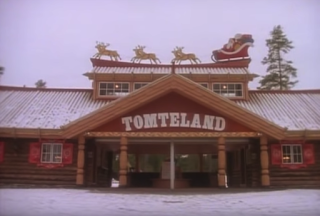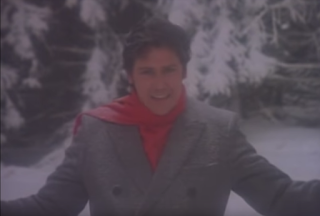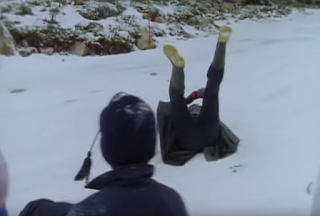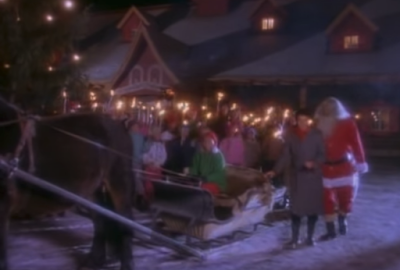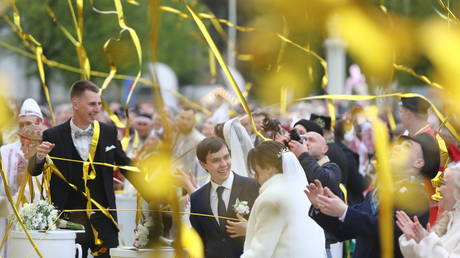Shakin’ Stevens as Odinic Archetype in the “Merry Christmas Everyone” Music Video
1,283 words
In the music video for “Merry Christmas Everyone” by Welsh rock ‘n’ roll singer Shakin’ Stevens, we see a clear example of the dormant Jungian Odinic archetype manifesting in popular culture. It begins with a towheaded Anglo-Saxon youth boarding an aeroplane and flying to Hyperborea, aka Tomteland, near Mora in Darlarna county, Sweden. Tomteland is translated by the “elves” who greet him as “Santa world” – however, this is only partly true. Jultomte is the Swedish translation of Santa Claus, but neither Santa Claus nor Father Christmas (yes, they were once separate things) were part of Nordic culture until recently. A Tomte or nisse is nowadays seen as a cute, elf-like thing, but, like elves themselves, are an echo of a forgotten cult of the ancestors. Tomte were associated with midwinter and with ancestors who first claimed and cleared the land, often ancient farmers. Another name for Tomte is the haugkall or haugebonde, from the Old Norse haugrmeaning a barrow – so we see a clear Indo-European connection to the worship of ancestral spirits at mounds.
After disembarking from a bus, the metaphorical vehicle to the Hyperborean land of the ancestors, we see that the youth is now accompanied by an Odinic figure in a grey coat, perhaps an echo of Odin’s other name, Hárbarðr, or “grey beard.” After a shot panning across the frosted lakes and snowy pine forests of the Nordic landscape, the shot fades to the man himself, the Odinic spirit made flesh to communicate the divine poetry, Shakin’ Stevens. The English child is a symbol of the Nordic soul, and his journey to Hyperborea is that of the aristocratic soul to the afterlife, which is guided by the psychopomp, Odin, over the rainbow bridge, Bifröst. Shakin’ Stevens is clearly a psychopomp who is guiding the souls, hence his prefix, “Shakin’,” for Bifröst is consistently referred to in Norse poetry as a bridge which “trembles,” thus Shakin’ Stevens “shakes” or “trembles” with the path to the beyond.
Next, we see Shakin’ on a horse-drawn sleigh, being pulled through the forest at night, like Odin, who leads the wild hunt. At his side is a Nordic “elf” who drives the horses on through the darkness. The association of Odin and elves is attested in the skaldic poem Austrfararvísur, by the Norwegian skald Sigvatr Þórðarson, who describes encountering a sacrifice to the elves in Sweden which one of the participants relates to their “fear of Odin” – and thus Odin is appeased via a sacrifice to the elves, which was at that time a broad term, describing many supernatural entities, including the souls of noble ancestors.
The lyrics at this stage reveal Shakin’s desire to “find that girl underneath the mistletoe.” Those familiar with Norse mythology will be well aware that mistletoe is the one entity, living or dead, in the entire cosmos that did not swear to Frigg not to harm Baldr, son of Odin. This leads to a dart of mistletoe being used to kill Baldr and causing all of creation to weep with sorrow. Baldr’s death is described differently in the Völuspá, Hákonarmál, Eriksmál, and in Gesta Danorum by Saxo Grammaticus, yet each hint at the resemblance between Baldr’s death and that of the noble souls of war dead, einherjar, whose sacrifice on the field of war wins them a place in Valhalla. Loki does not weep for Baldr’s death because it would annul the sacrifice, for only Loki knows that Baldr’s death is a necessary sacrifice for the renewal of the world. The poet of Völuspá specifies that Baldr will return:
All horror will be mended, Baldr will come; The two of them Baldr and Hodr
Will inhabit the victory settlements of Hroptr,
sanctuaries of choice-slaughter deities.
Thus, the association of the death of Baldr with a human sacrifice “choice-slaughter” which is necessary for renewal can also be seen in the context of the midwinter sacrifice and appeasement of “slaughter deities” for renewal of the earth for the following year. Thus, our Odinic guide’s lyrics refer to his desire for a human sacrifice, hinted at by reference to the mistletoe used in the sacrifice of Odin’s son, Baldr.
In the following verse, he sings, “Oh, I wish that Everyday was Christmas, What a nice way to spend the year” in a clear reference to the coming Fimbulvintr, a terrible winter which will last for three years and heralds the coming Ragnarök in which Odin will lead his army in battle against the forces of Chaos and trigger the death and renewal of the earth for the next cycle of time.
Next, in a workshop, the children (souls) are put to work creating toys, a clear metaphor for the einherjar training in Valhalla for the great battle of Ragnarök. They are guided now by Santa Claus, or as we say in Britain, Father Christmas, which is interesting because Jölföðr, or “Yule father,” is one of the names of Odin, as is Jölnir: “Yule figure.” Much has been written about the grey-bearded god’s resemblance to Santa Claus, but even if there is no direct historical link between them, the similarities can still be read from an esoteric perspective as a manifestation of the Odinic spirit, which Jung called an archetype, and which resides within the unconscious of all Northern Europeans. The metaphor of training for the final war is made explicit three minutes into the video, when Shakin’ and the children engage in a snowball fight. Shakin’ even throws a snowball at a snowman, which clearly represents Hrym, who shall lead the opposing forces of the frost giants at Ragnarök. This is followed by a tragic foreshadowing of Odin’s death at Ragnarök: Shaky is struck by a snowball and falls, representing Odin’s defeat by the wolf, Fenrir, who shall consume him.
After the training session, the souls of the dead return to the great hall to feast with Odin. Shakin’ is shown accompanied in his sleigh now by the Yule father himself, as it draws him to the great feasting hall. We are to assume that it is as this point that the “girl beneath the mistletoe” is offered to Shakin’ but, sadly, this is not shown. Any arguments that this video merely depicts a pop star taking some children on a festive holiday are rendered totally invalid by the final sequence. Shakin’, Yule father, his elves, and the Nordic-looking souls of the noble dead all leave the hall and brandish flaming torches as Shakin’ mounts the sleigh once more, and an elf drives it away into the dark forests of the Nordic night. The children and the Yule Father wave him goodbye and remain at the hall, for Shakin’ must return to Middle Earth to obtain more einherjar for the fateful war when he shall be no more, but the earth will be renewed by his son, Vali the avenger, just as the earth is renewed each year with the cycle of the seasons and the coming of Spring.
Hail the Yule Father! Hail Shakin’ Stevens! Very Indo-European!
The above is reprinted at the request of the author from the Survive the Jive blog. Thomas Rowsell has been running Survive the Jive, and its accompanying YouTube channel and Facebook page, since 2007, offering insight into Tradition, nature, and history. The site is an alternative media source, promoting anti-consumerist and anti-materialist perspectives with the intention of promoting indigenous and traditional cultures and metaphysics as a way to oppose globalization. Mr. Rowsell is also the author of the recently-published graphic novel, The Spirit of Yule, which depicts Anglo-Saxon pagan traditions surrounding Yule in a manner suitable for children.
The Dark Side of Progress:Jonathan Safran FoerR...
Loving Your Enemies: What’s Missing from the...
Les origines de la religion indo-européenne
The Trial of Socrates: Antiphon the Sophist
La Fin de l’Histoire Américaine
The Value of Truth & the Virtue of Honesty
Radicalized by Wikipedia
The Last Racialists: B. R. Myers’ The Cleane...


